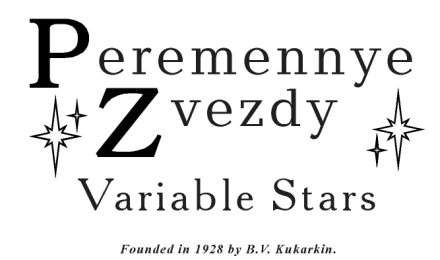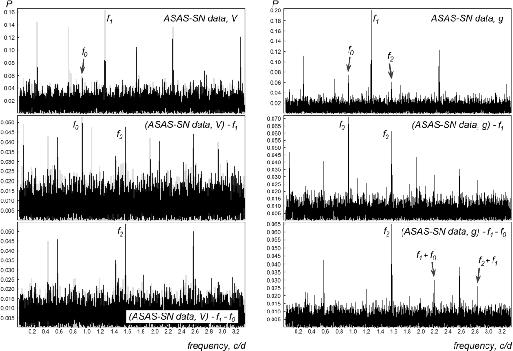|
Peremennye Zvezdy (Variable Stars) 42, No. 7, 2022 Received 7 June; accepted 26 June. |
Article in PDF |
|
DOI: 10.24412/2221-0474-2222-0474-2022-42-38-43
|
GSC 00143-00813, a New Triple-mode Classical Cepheid
A. V. Khruslov1,2
- Sternberg Astronomical Institute, Moscow State University,
Universitetskij pr. 13, Moscow 119992, Russia; khruslov@bk.ru
- Institute of Astronomy, Russian Academy of Sciences, Pyatnitskaya str. 48, Moscow 119017, Russia
| I present my detection of a new triple-mode Classical Cepheid, pulsating in the fundamental mode, first- and second-overtone modes. I analyzed all observations available for the star in the ASAS-SN and ZTF online public archives using the period-search software developed by Dr. V.P. Goranskij for Windows environment. Light elements and parameters of the light curves for the three oscillations were obtained. |
1. Introduction
Triple-mode Classical Cepheids, pulsating in the fundamental mode,
first- and second-overtone modes (C012), are a very rare stellar
variability subtype. For a long time, this group included only two
stars. One of them, AC And, was discovered by Florya (1937) as a
double-mode variable; later, Fitch & Szeidl (1976) detected an
additional third radial mode (the second overtone). Variability
and multiperiodicity of the second of such stars, V823 Cas, were
detected by Antipin (1997). Both stars have short periods (![]() 0.71 and 0.67 respectively) and are classified not as Cepheids in
the AAVSO
VSX1database (AC And as an RRd star, V823 Cas as a HADS(B) variable).
In the GCVS catalog (Samus et al., 2017), both variables were
classified as unique stars (marked with an asterisk in the
"Type" column).
0.71 and 0.67 respectively) and are classified not as Cepheids in
the AAVSO
VSX1database (AC And as an RRd star, V823 Cas as a HADS(B) variable).
In the GCVS catalog (Samus et al., 2017), both variables were
classified as unique stars (marked with an asterisk in the
"Type" column).
The OGLE Collection of Variable
Stars2(Udalski et al., 2018) contains two C012 stars in the Galactic
disk (OGLE-GD-CEP-1011 and OGLE-GD-CEP-1704) and one C012 star in
the Large Magellanic Cloud (OGLE-LMC-CEP-1378). In addition, one
star is classified as a Galactic anomalous Cepheid pulsating in
the fundamental mode, first- and second-overtone modes
(OGLE-GAL-ACEP-091, Soszynski et al. 2020) and one triple-mode
variable is classified as a Galactic bulge anomalous RRd star
pulsating in the same three main modes with ![]() days
(OGLE-BLG-RRLYR-38791; Soszynski et al., 2017). According to the
cited authors, the classification of the last of these objects is
unclear.
days
(OGLE-BLG-RRLYR-38791; Soszynski et al., 2017). According to the
cited authors, the classification of the last of these objects is
unclear.
Jurcsik et al. (2018) detected multi-periodicity of ASASSN-V J065759.86+053444.9, a C012 classical Cepheid.
An interesting case is a V0979 Mon. The double periodicity of this star was detected by the author (Khruslov, 2009), the variable was classified as a first- and second-overtone Cepheid using ASAS-3 data (Pojmanski, 2002). Poretti et al. (2014) detected the third oscillation (fundamental mode) using CoRoT data (therefore, the type is C012). In the OGLE Collection of Variable Stars, this star, OGLE-GD-CEP-0057, is a classical Cepheid pulsating in the first- and second-overtone modes. I analyzed all available observations from the All-Sky Automated Survey for Supernovae (ASAS-SN; Shappe et al., 2014, Kochanek et al., 2017) and the Zwicky Transient Facility (ZTF; Bellm et al., 2019; Masci et al., 2019) archives, re-analyzed OGLE data, and did not detect the fundamental-mode oscillation in any of these photometric series. Mode switching or amplitude modulation of the fundamental mode are not excluded; my result can also be explained with insufficient accuracy or completeness of the analyzed data.
In this paper, I present my detection of a new triple-mode Cepheid
of the C012 subtype. Variability of GSC 00143-00813 = USNO-B1.0
0970-0096856, RA(J2000) = 06![]() 13
13![]() 37
37![]() 33, Dec(J2000) =
+07
33, Dec(J2000) =
+07![]() 02
02![]() 35
35
![]() 0, was announced in the First Catalog of
Variable Stars Measured by the Asteroid Terrestrial-impact Last
Alert System (ATLAS, Heinze et al., 2018). The variable was
designated as ATO J093.4055+07.0430, type IRR (irregular
variables). The star is contained in the ASAS-SN Catalog of
Variable Stars, part IX (ASASSN-V J061337.33+070234.7, Jayasinghe
et al., 2021), where the variable was classified as a DCEP star,
period
0, was announced in the First Catalog of
Variable Stars Measured by the Asteroid Terrestrial-impact Last
Alert System (ATLAS, Heinze et al., 2018). The variable was
designated as ATO J093.4055+07.0430, type IRR (irregular
variables). The star is contained in the ASAS-SN Catalog of
Variable Stars, part IX (ASASSN-V J061337.33+070234.7, Jayasinghe
et al., 2021), where the variable was classified as a DCEP star,
period
![]() . However, the variable was classified
as an RR Lyrae star in the Zwicky Transient Facility Catalog of
Periodic Variable Stars (ZTFJ061337.32+070235.0, Chen et al.,
2020), where the period is given in two versions:
. However, the variable was classified
as an RR Lyrae star in the Zwicky Transient Facility Catalog of
Periodic Variable Stars (ZTFJ061337.32+070235.0, Chen et al.,
2020), where the period is given in two versions:
![]() from
from ![]() -band data or
-band data or
![]() from
from
![]() -band data. In the AAVSO VSX database, the variable is listed
as an RRAB star.
-band data. In the AAVSO VSX database, the variable is listed
as an RRAB star.
I analyzed all observations available for this star in the ASAS-SN3 and ZTF (the SNAD ZTF viewer4, Malanchev et al., 2021) online public archive using Deeming's method (Deeming, 1975) implemented in the WinEfk5 code written by V.P. Goranskij. My study detected oscillations in the fundamental mode, first- and second-overtone modes.
The radial pulsation modes were identified by the period ratio
(
![]() ), see the study on this problem in
Petersen (1973), Smolec & Moskalik (2010).
), see the study on this problem in
Petersen (1973), Smolec & Moskalik (2010).
The star was identified in the GSC (Morrison et al., 2001) and USNO-B1.0 (Monet et al., 2003) catalogs. The tabulated coordinates of the variable were drawn from the Gaia EDR3 catalogue (Gaia Collaboration, 2021).
The data from the ASAS-SN and ZTF surveys are available online in the html version of this paper as a zip-archive. The finding chart is displayed in Fig. 1.
2. Results
The light elements of GSC 00143-00813 were derived using the
ASAS-SN and ZTF data. Information on the light elements of three
radial pulsation modes is presented in the Table: period in days,
epoch of maximum (HJD - 2457777.0), semi-amplitudes in the ![]() and
and ![]() bands from ASAS-SN data, in the
bands from ASAS-SN data, in the ![]() and
and ![]() bands from ZTF
data.
bands from ZTF
data.
The period ratios,
![]() and
and
![]() , are
typical of pulsations in the fundamental mode, first- and
second-overtone modes. The first-overtone period is dominating.
, are
typical of pulsations in the fundamental mode, first- and
second-overtone modes. The first-overtone period is dominating.
GSC 00143-00813 is located at a small distance from the Galactic
plane, its galactic latitude is
![]() , which suggests its
classification as a classical Cepheid.
, which suggests its
classification as a classical Cepheid.
| Period, d | 1.070450 | 0.788585 | 0.635820 | |
| Epoch, HJD 2457777+ | 0.780 | 0.470 | 0.047 | |
| Semi-amplitude, | 0.056 | 0.165 | 0.050 | |
| 0.064 | 0.202 | 0.062 | ||
| 0.035 | 0.140 | 0.039 | ||
| 0.068 | 0.206 | 0.062 |
The range of variability, according to ASAS-SN data, is
![]() in the
in the ![]() band and
band and
![]() in the
in the ![]() band. The range of variability. according to ZTF data, is
band. The range of variability. according to ZTF data, is
![]() in the
in the ![]() band and
band and
![]() in
the
in
the ![]() band.
band.
The color indices are: ![]() (2MASS; Skrutskie et al.,
2006);
(2MASS; Skrutskie et al.,
2006); ![]() (APASS6).
(APASS6).
In addition to the three main modes, I detected the following
interaction frequencies: in the ZTF data (![]() and
and ![]() bands),
bands),
![]() and
and ![]() ; in the ASAS-SN data (
; in the ASAS-SN data (![]() band),
band),
![]() ,
, ![]() ,
, ![]() ,
, ![]() , and
, and ![]() .
.
Power spectra of the variable from all analyzed data, for the raw
data and after consecutive subtraction of the fundamental-mode
oscillation, are shown in Fig. 2 (ASAS-SN, ![]() and
and ![]() bands) and
Fig. 3 (ZTF,
bands) and
Fig. 3 (ZTF, ![]() and
and ![]() bands). In all the panels, the structure
of the power spectra shows that the fundamental and
second-overtone modes are real.
bands). In all the panels, the structure
of the power spectra shows that the fundamental and
second-overtone modes are real.
The phased light curves of GSC 00143-00813 from ASAS-SN and ZTF data are displayed in Figs. 4 and 5.
Acknowledgments: The author wishes to thank Dr.
V.P. Goranskij for providing his software.
References:
Antipin, S., 1997, Astron. & Astrophys., 326, L1
Bellm, E. C., Kulkarni, S. R., Graham, M. J., 2019, Publ. Astron. Soc. Pacific, 131, 018002
Chen, X., Wang, S., Deng, L., et al., 2020, Astrophys. J. Suppl. Ser., 249, id. 18
Deeming, T. J., 1975, Astrophys. & Space Sci., 36, 137
Fitch, W. S., Szeidl, B., 1976, Astrophys. J., 203, 616
Florya, N. F., 1937, Astron. Zh., 14, 32
Gaia Collaboration: Brown, A. G. A., Vallenari, A., Prusti, T., et al., 2021, Astron. & Astrophys., 649, article id. A1
Heinze, A. N., Tonry, J. L., Denneau, L., et al., 2018, Astron. J., 156, article id. 241
Jayasinghe, T., Kochanek, C. S., Stanek, K. Z., et al., 2021, Mon. Notices Roy. Astron. Soc., 503, 200
Jurcsik, J., Hajdu, G., Catelan, M., 2018, Acta Astron., 68, 341
Khruslov, A. V., 2009, Perem. Zvezdy Prilozh., 9, 31
Kochanek, C. S., Shappee, B. J., Stanek, K. Z., et al., 2017, Publ. Astron. Soc. Pacific, 129, 104502
Malanchev, K. L., Pruzhinskaya, M. V., Korolev, V. S., et al., 2021, Mon. Notices Roy. Astron. Soc., 502, 5147
Masci, F. J., Laher, R. R., Rusholme, B., 2019, Publ. Astron. Soc. Pacific, 131, 018003
Monet, D. G., Levine, S. E., Canzian, B., et al., 2003, Astron. J., 125, 984
Morrison, J. E., Röser, S., McLean, B., et al., 2001, Astron. J., 121, 1752
Petersen, J. O., 1973, Astron. & Astrophys., 27, 89
Pojmanski, G., 2002, Acta Astron., 52, 397
Poretti, E., Baglin, A., Weiss, W. W., 2014, Astrophys. J. Lett., 795, L36
Samus, N. N., Kazarovets, E. V., Durlevich, O. V., Kireeva, N. N., Pastukhova, E. N., 2017, Astron. Rep., 61, 80
Shappee, B. J., Prieto, J. L., Grupe, D., et al., 2014, Astrophys. J., 788, 48
Skrutskie, M. F., Cutri, R. M., Stiening, R., et al., 2006, Astron. J., 131, 1163
Smolec, R., Moskalik, P., 2010, Astron. & Astrophys., 524, A40
Soszynski, I., Smolec, R., Udalski, A., et al., 2020, Astrophys. J. Lett., 901, L25
Soszynski, I., Udalski, A., Szymanski, M. K., et al., 2017, Acta Astron., 67, 297
Udalski, A., Soszynski, I., Pietrukowicz, P., et al., 2018, Acta Astron., 68, 315





